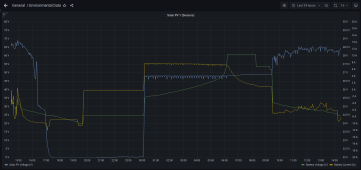Hi,
I have a small 'off-grid' solar PV system, 2 x 325W panels, Victron 100/20 MPPT charger, 4 x Exide AGM batteries giving me 24v and a Victron 800W Phoenix inverter.
This summer has been good for solar power, but now the solar power available is falling I'm looking at using the PV system to make better use of the Economy 7 electricity we have available. What I want to do is to charge the batteries overnight and make use of the power during the day, any solar power available will be a bonus. I can simply add a Victron grid powered charger in parallel with the MPPT charger, at about £170, but I already have a perfectly adequate charger in the Victron MPPT unit.
My engineering background tells me I should be able to connect a simple unregulated supply with a suitable current limit in parallel with the solar panels, a couple of 10amp power diodes can provide suitable isolation. I can build a nominal 60v unregulated supply with a 5amp current limit for a few pounds, which will give me ~300W of usable power. I'm assuming the MPPT charger would find the peak power point, i.e. just as the 5amp current limit kicks in.
Any one tried this, or got any experience with replacing the solar panels with a dc supply ? I'm wary of damaging the MPPT charger if, for instance, the MPPT algorithm doesn't function properly with a dc supply rather than solar panels.
Regards
PaulM
I have a small 'off-grid' solar PV system, 2 x 325W panels, Victron 100/20 MPPT charger, 4 x Exide AGM batteries giving me 24v and a Victron 800W Phoenix inverter.
This summer has been good for solar power, but now the solar power available is falling I'm looking at using the PV system to make better use of the Economy 7 electricity we have available. What I want to do is to charge the batteries overnight and make use of the power during the day, any solar power available will be a bonus. I can simply add a Victron grid powered charger in parallel with the MPPT charger, at about £170, but I already have a perfectly adequate charger in the Victron MPPT unit.
My engineering background tells me I should be able to connect a simple unregulated supply with a suitable current limit in parallel with the solar panels, a couple of 10amp power diodes can provide suitable isolation. I can build a nominal 60v unregulated supply with a 5amp current limit for a few pounds, which will give me ~300W of usable power. I'm assuming the MPPT charger would find the peak power point, i.e. just as the 5amp current limit kicks in.
Any one tried this, or got any experience with replacing the solar panels with a dc supply ? I'm wary of damaging the MPPT charger if, for instance, the MPPT algorithm doesn't function properly with a dc supply rather than solar panels.
Regards
PaulM



